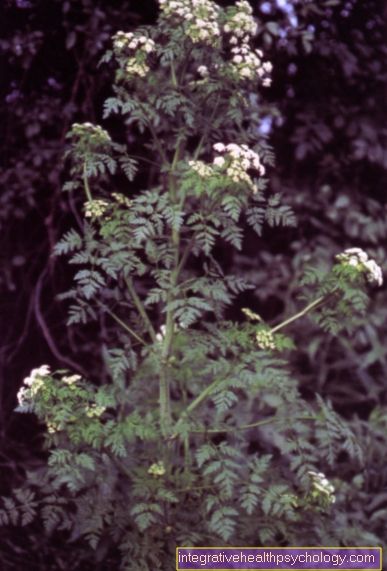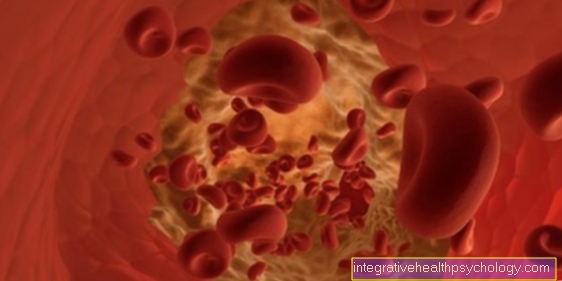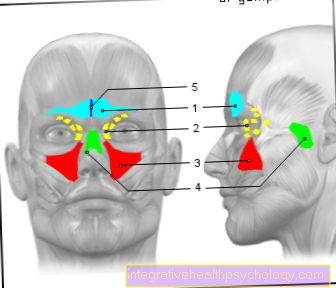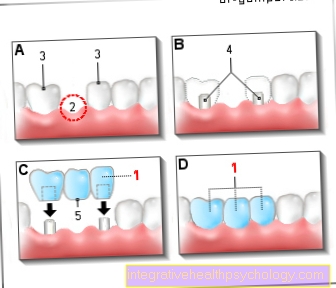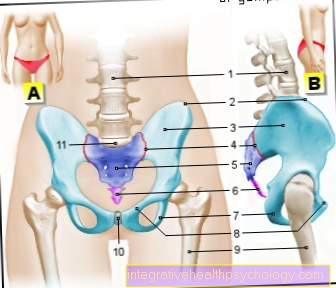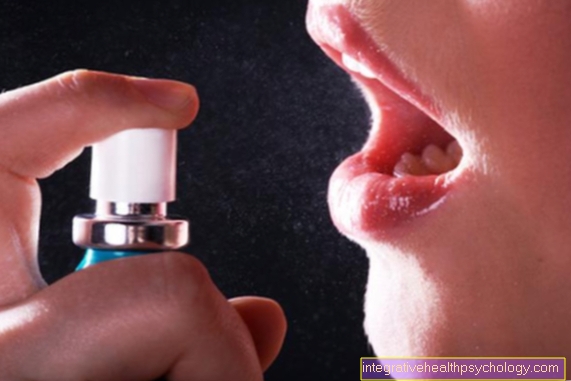Tomato allergy
definition
A tomato allergy is characterized by an excessive reaction of the immune system to the consumption of tomatoes.
However, those affected are less likely to be allergic to the tomato itself. Rather, the tomato contains the substance histamine, which plays an important role in the immune system in the case of allergies.

Affected people usually have a histamine intolerance, which acts like a tomato allergy. The histamine releases various immune substances that trigger typical symptoms such as itching, burning on the tongue, nausea, vomiting and diarrhea.
Learn more about this at: Histamine intolerance
A tomato allergy can be recognized by these symptoms
The symptoms of a tomato allergy always appear at a certain time after the tomatoes have been consumed. The symptoms include gastrointestinal symptoms such as nausea, vomiting, abdominal pain and diarrhea.
In the case of more severe allergies, the oropharynx can also be affected. There is a burning sensation or itching on the mucous membranes and on the tongue. Redness and swelling are also possible. An extended allergic reaction also includes a skin rash, which is usually located near the contact area with the tomato (i.e. on the face, especially around the mouth).
Symptoms on the tongue in a tomato allergy
When eating tomatoes, the tongue comes into direct contact with the allergen. Therefore, the symptoms can be particularly severe there.
This includes burning and itching on the tongue. Redness or even small blisters can be a sign of a tomato allergy. In severe cases, contact with tomatoes will cause the tongue to swell significantly, which can cause breathing problems. If the swelling is so severe that the throat is also affected, it can even lead to life-threatening shortness of breath.
Itching with tomato allergy
In contact with tomatoes, the immune system of allergy sufferers reacts more intensely to actually harmless substances. The body interprets the tomato or its ingredients as a dangerous substance and therefore tries to fight it.
This process leads to an increased release of immune cells and signal substances that put the body on alert. These released substances are distributed in the body as quickly as possible so that an optimal defense against the tomato, which is classified as dangerous, can take place. These well-distributed substances irritate the nerve endings and cause itching.
You might also be interested in: Tomato rash
Diarrhea with tomato allergy
In addition to nausea, vomiting, flatulence and abdominal pain, diarrhea is one of the symptoms of the gastrointestinal tract that occurs particularly in the case of allergies to food.
In the intestine, the food is usually broken down into its individual components and then absorbed into the blood. Due to the strong shredding, the body has contact with the ingredients of the tomato in many places and inevitably also with the histamine, to which the immune system reacts more intensely.
One of the goals of this allergic reaction is to quickly remove the tomato from the intestine. Such removal is very quick with the help of diarrhea, which is why the body uses diarrhea as an effective defense strategy.
Symptoms of the eyes in a tomato allergy
The eyes are typically not affected in a tomato allergy.
They are more likely to react with a cross allergy, for example when a person is allergic to birch pollen. Due to the chemical similarity of the substances, there is also an allergic reaction to the tomato. This can be expressed by a constantly runny nose, which in turn affects the eyes.
Nevertheless, the typical allergic symptoms such as burning or itching of the eyes, plus redness and swelling, are rare in tomato allergies.
Treatment of tomato allergy
The most effective therapy for allergies is to completely avoid the food that triggers the allergy. So if you suffer from a tomato allergy, you can do without tomatoes for life and thus save yourself any allergy symptoms that can be triggered by tomatoes.
A correct and clear diagnosis of the allergen is important for this, so that this food waiver can be carried out correctly. Since the allergic reaction to tomatoes is mainly due to the substance histamine, so-called antihistamines are often used drugs. These tablets block the additional release of histamine in the body, which can help reduce symptoms. However, the antihistamines cannot cure the disease as they cannot address the root cause.
You can also find out more at: Food allergy therapy
As with any other allergy, every allergy sufferer should be prepared for an emergency, i.e. a life-threatening allergic shock. The emergency kit, which consists of an Epi-Pen containing the active ingredient epinephrine (also called adrenaline), and possibly additional sprays containing cortisone, is used for this purpose.An allergic shock leads to severe shortness of breath and a circulatory collapse within a few seconds to minutes. The adrenaline from the Epi-Pen can usually still be applied by the person concerned and counteracts the allergic shock within a very short time.
Also read: Allergy emergency kit
Causes of Tomato Allergy
The exact cause of the tomato allergy has not yet been clarified.
However, it is certain that there is a genetic component. Parents who have food allergies are at greater risk of being allergic to food themselves.
There is also the theory that a particularly clean environment leads to an increased susceptibility to allergies. In a clean environment, the body does not come into contact with many substances. He cannot get used to the substances and considers them dangerous if they come into contact later. This leads to the strong immune reaction to actually harmless food like the tomato.
Cross allergy in tomato allergy
Cross-allergies arise due to the chemical similarity of the allergens (allergy-causing substances) in different foods. In this way, the immune system not only recognizes the actual food that someone is allergic to. Other foods or pollen are also interpreted as dangerous and therefore attacked by the body. The birch tree in particular causes cross-allergies with tomatoes. Other foods can also cause cross-allergies, including cherries, pears, apples, as well as hazelnuts and almonds. Banana, orange and mango are less common.
Learn more at: Cross allergy
That is why you react to fresh tomatoes and not to cooked ones
The allergic reaction to certain foods is caused by an excessive reaction of the immune system to the foreign substance. Normally, the body comes into contact with the substance for the first time, whereupon immune cells are formed that recognize certain surface proteins (proteins on the surface of the substance). Upon second contact with the affected food, the immune system recognizes these surface proteins based on the immune cells that have already been formed. This mechanism is actually intended as a defense against dangerous substances.
In the event of an allergic reaction, however, the body reacts to an actually harmless substance with an excessive immune response. The key stimulus for the immune system is the recognition of the surface proteins mentioned above. In the case of a fresh tomato, these are configured in the way that the immune system detected them upon initial contact. Heating the tomatoes also heats these surface proteins. The proteins are denatured, the superficial proteins are destroyed by heating, or their shape changes. The body's immune cells can no longer recognize the tomato proteins and there is no immune reaction against the heated tomato.
Diagnosing a tomato allergy
The tomato allergy is first diagnosed on the basis of the anamnesis. The doctor asks about the symptoms of the person concerned. The temporal relationship between the consumption of the tomato and the onset of symptoms such as itching, diarrhea and nausea is particularly important. If these symptoms can be attributed to tomato consumption without any doubt, further diagnostics can be dispensed with.
However, the so-called prick test is used to carry out a reliable diagnosis. To do this, a minimal amount of the tomato allergens is injected under the skin of the person concerned. In the event of a tomato allergy, a skin reaction in the form of reddening, swelling and itching is then expected at the site of the injection.
also read: Test for a food allergy
Duration and prognosis of tomato allergy
The tomato allergy is basically an incurable disease. Since the exact causes and disease mechanisms have not yet been fully clarified, there is still no curative therapy option. So the tomato allergy lasts a lifetime.
Nevertheless, the duration of the individual allergic attacks strongly depends on how strictly the person concerned adheres to the avoidance of tomatoes. The severity of the reaction also varies greatly from person to person.
Read on below: Allergic reaction
Course of the disease in tomato allergy
An allergic reaction cannot develop until the second contact with the affected allergen at the earliest. First of all, the immune system must come into contact with the allergen. Antibodies are formed against the substance. On the second contact with the allergen, these alert the immune system and attack the substance.
The further course depends heavily on the frequency of tomato consumption. Those who do not eat tomatoes will likely never experience symptoms again. Anyone who comes into contact with tomatoes frequently and consumes them can usually perceive an intensification of the allergy.
Recommendations from the editorial team
You might also be interested in:
- Histamine intolerance
- Food allergy test
- Food allergy therapy
- Allergy emergency kit
- Allergic reaction






